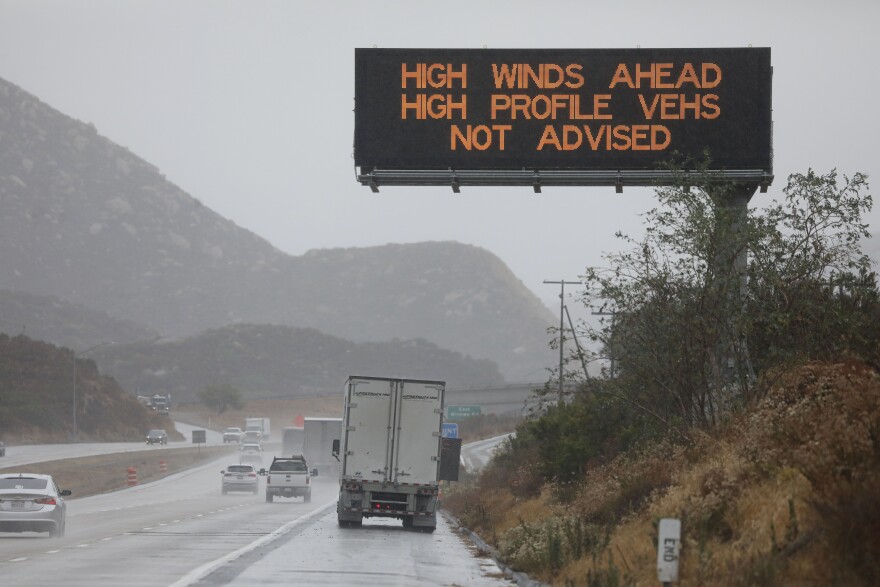Truth matters. Community matters. Your support makes both possible. LAist is one of the few places where news remains independent and free from political and corporate influence. Stand up for truth and for LAist. Make your year-end tax-deductible gift now.
Cheat sheet: Your very short guide to driving in high winds and fire danger

These fires are fast-moving and straight up frightening. For the most up-to-date information about the fire you can check:
Palisades Fire
Eaton Fire
Watch CalFire for new incidents ▶
Please, if you must drive be aware that road conditions are treacherous. We are hearing of debris on the road and power outages causing traffic lights to go dark.
Driving basics
Advice from state safety officials and AAA on driving safely in strong winds
Park in covered areas like a garage. If you must park on the street, avoid narrow streets to allow emergency vehicles to pass through easily, and stay clear of parking under trees that can be easily uprooted or structures that could topple.
Fill up on gas, in case you need to evacuate.
When driving on freeways and busy streets, stick to the speed limit and avoid hard braking.
Keep a safe distance between you and the vehicle in front of you.
Keep an eye out for hazards on the road, especially if they can impede visibility. Pull over and wait for the winds to subside if you must.
Avoid driving behind high-profile vehicles or vehicles towing other cars as they can topple easily.
If you come to a traffic light that's out, treat it like a stop sign and take turns going through the intersection following the rules of the road.
If you must evacuate in fire conditions
Zooming away from a fire might make you feel safer but there are still precautions you should take while driving:
- Drive slowly with your lights on. Watch out for fleeing livestock, animals, and people. Watch for traffic signals that may be out. Approach those intersections as four-way stops.
- Avoid downed power lines or dangling wires. Even if it appears not to be live, don't touch it or even approach it. Call 911 immediately.
- Vehicles offer no protection from radiant heat. Stay in the car only as the absolute last resort with the engine running, the windows up and vents closed, and the air conditioner on with the air circulating.
- Protect yourself from the heat and flying embers: Wear clothing that can protect your arms and legs, heavy duty shoes and make sure to protect your eyes with goggles or glasses. Wear a mask if you can.
Evaluate your risks
Want to take a closer look at some of your potential risks? First Street Foundation, a non-profit research group, has a new tool, called Risk Factor: Input your address for data about the risk for fire and flooding in your area. (The website notes, however, that this should not be relied upon for in-the-moment details about "active events.")
Sign up for local alerts
Sign up for local alerts. They’re a reliable clearinghouse for up-to-date news, and early warnings.
- L.A. County alerts ▶
- Orange County alerts ▶
- Ventura County alerts ▶
- San Bernardino County alerts ▶
- Riverside County alerts ▶
- Santa Barbara County alerts ▶
Be familiar with your reliable local news sources (we do our best here at LAist.com and LAist 89.3 to stay on top of any Southern California fires that lead to evacuations.)
- Bookmark Fire.CA.Gov/Incidents, which gives you an at-a-glance look at blazes in progress. This is especially important if you plan on traveling.
- ReadyForWildfire.org is your friend to get everything prepped. It guides you through the three critical stages: READY (go bag prepped), SET (the ability to leave at a moment’s notice), nGO (get out of there as soon as authorities give the word.) It’s a great starting place on how to prepare your home and family.
-
Listen to our Big Burn podcast
_
Resources to prep and cope with wildfire
- Wildfires are getting worse. What you need to know
- Every day is now fire season. Let's get you ready for the next wildfire burning near you
- Evacuation terms can be confusing. Here’s what they mean and how to sign up for alerts
- How to keep yourself safe from wildfire smoke
- This is why fire officials don't want you to stay and defend your home
- What does 'containment' of a fire mean, exactly
- What to do — and not do — when you get home after a wildfire
- If you want to help fire victims, resist the urge to volunteer








